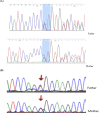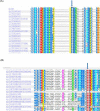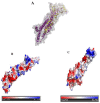Utilization of Whole Exome Sequencing in Lethal Form of Multiple Pterygium Syndrome: Identification of Mutations in Embryonal Subunit of Acetylcholine Receptor
- PMID: 32587836
- PMCID: PMC7305466
- DOI: 10.22088/IJMCM.BUMS.8.4.258
Utilization of Whole Exome Sequencing in Lethal Form of Multiple Pterygium Syndrome: Identification of Mutations in Embryonal Subunit of Acetylcholine Receptor
Abstract
The acetylcholine receptor (AChR) is a member of the superfamily of transmitter-gated ion channels having a critical role in controlling electrical signals between nerves and muscle cells. Disruptive mutations in genes encoding different subunits of AChR result in multiple pterygium syndrome (MPS), which can be associated with a severe prenatally lethal presentation. This study aimed to investigate the etiology of lethal MPS (LMPS) in two consanguineous families with a history of miscarriages. DNA was extracted from a tissue sample of two aborted fetuses (probands) from two different families with a history of spontaneous miscarriages. Parental peripheral blood samples were collected for confirmatory analysis and follow-up testing. Whole-exome sequencing (WES) was performed on DNA from the probands. The results were confirmed and segregated by Sanger sequencing. Moreover, protein structure evaluations were accomplished. We identified a homozygous frameshift mutation of c.753_754delCT (p.V253fs*44) and a homozygous missense mutation of c.715C>T (p.Arg239Cys) in the CHRNG gene. Both aborted fetuses had pterygium, severe arthrogryposis, and fetal hydrops with cystic hygroma, being compatible with LMPS. The heterozygous state was confirmed in parents for both CHRNG variants. Likewise, CHRNG mutation was predicted to display the damaging effects by lowering the number of helixes and modifying the surface electrostatic potential. The present study identified rare sequence variants in the CHRNG gene in aborted fetuses from consanguineous couples with recurrent miscarriage history. WES is a comprehensive and cost-effective approach to study heterogeneous diseases including MPS. Such findings can improve our knowledge of MPS databases, particularly for genetic counseling of high-risk families and preimplantation genetic diagnosis.
Keywords: CHRNG; Multiple pterygium syndromes; recurrent abortion; whole-exome sequencing.
Figures







Similar articles
-
Truncating CHRNG mutations associated with interfamilial variability of the severity of the Escobar variant of multiple pterygium syndrome.BMC Genet. 2016 May 31;17(1):71. doi: 10.1186/s12863-016-0382-5. BMC Genet. 2016. PMID: 27245440 Free PMC article.
-
CHRNG genotype-phenotype correlations in the multiple pterygium syndromes.J Med Genet. 2012 Jan;49(1):21-6. doi: 10.1136/jmedgenet-2011-100378. J Med Genet. 2012. PMID: 22167768
-
Rare cases of congenital arthrogryposis multiplex caused by novel recurrent CHRNG mutations.J Hum Genet. 2015 Apr;60(4):213-5. doi: 10.1038/jhg.2015.2. Epub 2015 Jan 22. J Hum Genet. 2015. PMID: 25608830
-
CHRNG-related nonlethal multiple pterygium syndrome: Muscle imaging pattern and clinical, histopathological, and molecular genetic findings.Am J Med Genet A. 2019 Jun;179(6):915-926. doi: 10.1002/ajmg.a.61122. Epub 2019 Mar 14. Am J Med Genet A. 2019. PMID: 30868735 Review.
-
Prenatal diagnosis and genetic analysis of fetal akinesia deformation sequence and multiple pterygium syndrome associated with neuromuscular junction disorders: a review.Taiwan J Obstet Gynecol. 2012 Mar;51(1):12-7. doi: 10.1016/j.tjog.2012.01.004. Taiwan J Obstet Gynecol. 2012. PMID: 22482962 Review.
Cited by
-
Case Report: Novel compound heterozygous variants in CHRNA1 gene leading to lethal multiple pterygium syndrome: A case report.Front Genet. 2022 Aug 26;13:964098. doi: 10.3389/fgene.2022.964098. eCollection 2022. Front Genet. 2022. PMID: 36092864 Free PMC article.
References
-
- Hall JG, Reed SD, Rosenbaum KN, et al. Limb pterygium syndromes: a review and report of eleven patients. Am J Med Genet. 1982;12:377–409. - PubMed
-
- Chen CP. Prenatal diagnosis and genetic analysis of fetal akinesia deformation sequence and multiple pterygium syndrome associated with neuromuscular junction disorders: a review. Taiwan J Obstet Gynecol. 2012;51:12–7. - PubMed
-
- Kawira EL, Bender HA, Opitz JM, et al. An unusual distal arthrogryposis. Am J Med Genet. 1985;20:425–9. - PubMed
LinkOut - more resources
Full Text Sources
